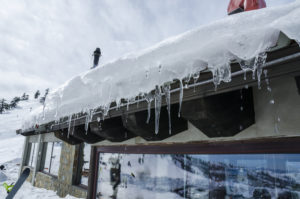 When winter comes, ice dams develop at the edge of your roof. The ridge of ice allows water from melting ice to leak into your building, which can damage insulation, the ceiling, and walls. Ice dams occur when snow falls on your roof, and the surface temperature allows ice to form.
When winter comes, ice dams develop at the edge of your roof. The ridge of ice allows water from melting ice to leak into your building, which can damage insulation, the ceiling, and walls. Ice dams occur when snow falls on your roof, and the surface temperature allows ice to form.
If not addressed immediately, you could spend winter repairing your roof and the interior of your building. It is not a scenario you want to be in during cold season because it can slow down operations and cost your business more money.
Ice Dam Prevention
One way to prevent ice dam is to improve building ventilation and setting up electric power vents with thermostats. To avoid the buildup of branches and tree leaves that block roof drainage, trim the trees hanging over your roof. Check whether the downspouts, gutters, scuppers, and drains are free from vegetation and debris.
You also need to increase the insulation above the ceiling, and set up self-regulating heating cables around roof drains, on downspouts and gutters. Also, keep your building in good condition by scheduling a roof preventive maintenance, as well as periodic drainage inspections.
Commercial roofing professionals can also recommend the right systems to reduce the damage ice dams can cause. For example, flatter roofing systems are more vulnerable to ice ridge formation because they prevent water from flowing into drains.
Ice Dam Removal
The Insurance Institute for Business and Home Safety is against the removal of ice dams through braking or chipping. This approach will damage your roof, whether it is a steep sloped roof or a flat one. When snow forms on your roof, remove it instantly.
Prevent or get rid of ice dams. With an early response and sound approach, you can stop ice ridge from costing your business thousands on repair expenses.

